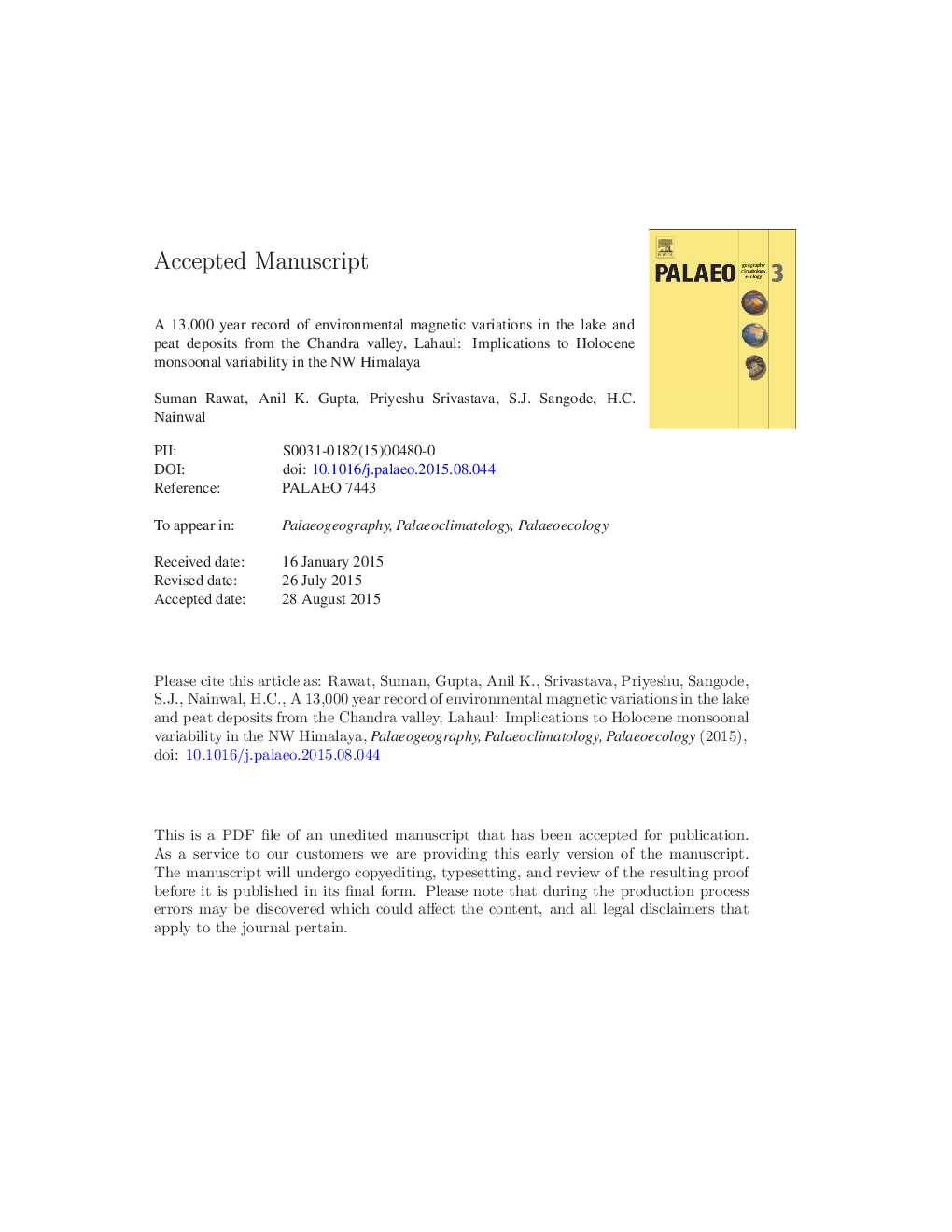| کد مقاله | کد نشریه | سال انتشار | مقاله انگلیسی | نسخه تمام متن |
|---|---|---|---|---|
| 6349493 | 1622150 | 2015 | 44 صفحه PDF | دانلود رایگان |
عنوان انگلیسی مقاله ISI
A 13,000Â year record of environmental magnetic variations in the lake and peat deposits from the Chandra valley, Lahaul: Implications to Holocene monsoonal variability in the NW Himalaya
دانلود مقاله + سفارش ترجمه
دانلود مقاله ISI انگلیسی
رایگان برای ایرانیان
کلمات کلیدی
موضوعات مرتبط
مهندسی و علوم پایه
علوم زمین و سیارات
فرآیندهای سطح زمین
پیش نمایش صفحه اول مقاله

چکیده انگلیسی
An ~ 13,000 year old record of in situ peat bog and lacustrine sediments from a post glacial lake in the Chandra valley of the Lahaul Himalaya is studied to generate the record of environmental magnetic signatures in response to Indian summer monsoon (ISM) variability in the NW Himalaya. The chronology of studied Chandra Peat Trench (CPT) profile is based on 9 AMS 14C calibrated dates (cal yr BP). The piece-wise linear regression analysis of age-depth model indicates non-linear sedimentation with higher rates from ~ 4142 cal yr BP to the Present and lower accumulation during ~ 12,880-4142 cal yr BP. The mineral magnetism showed three dominant assemblages of magnetic minerals with varying concentrations in peat-lake sediment sequence i.e. (1) mixed ferri- and antiferromagnetic minerals between ~ 12,880 and 11,019 cal yr BP, (2) dominant antiferromagnetic mineralogy from ~ 11,019 to 3172 cal yr BP, and (3) significantly increased concentrations of mixed ferri- and antiferromagnetic minerals from ~ 3172 cal yr BP to the Present with characteristically increased ferrimagnetic concentrations after ~ 2032 cal yr BP. The characteristic increase in antiferromagnetic mineral concentration accompanied by decreased ferrimagnetic concentration from ~ 10,398 to 5770 cal yr BP suggest possible oxidation of magnetite to hematite under warmer climate conditions and corresponds to increased ISM intensity during early to mid-Holocene warm-wet climate in the NW Himalaya. The distinctly increased concentration of antiferromagnetic minerals from ~ 6732 to 5770 cal yr BP indicates mid-Holocene climate optimum (HCO) in the Lahaul Himalaya. The strengthening and weakening of ISM recorded in environmental magnetic signatures during ~ 1260-852 cal yr BP (~ 690-1098 AD) and between ~ 852 and 239 cal yr BP (~ 1098-1711 AD) corresponds to Medieval Warm Period (MWP) and Little Ice Age (LIA) events, respectively.
ناشر
Database: Elsevier - ScienceDirect (ساینس دایرکت)
Journal: Palaeogeography, Palaeoclimatology, Palaeoecology - Volume 440, 15 December 2015, Pages 116-127
Journal: Palaeogeography, Palaeoclimatology, Palaeoecology - Volume 440, 15 December 2015, Pages 116-127
نویسندگان
Suman Rawat, Anil K. Gupta, Priyeshu Srivastava, S.J. Sangode, H.C. Nainwal,